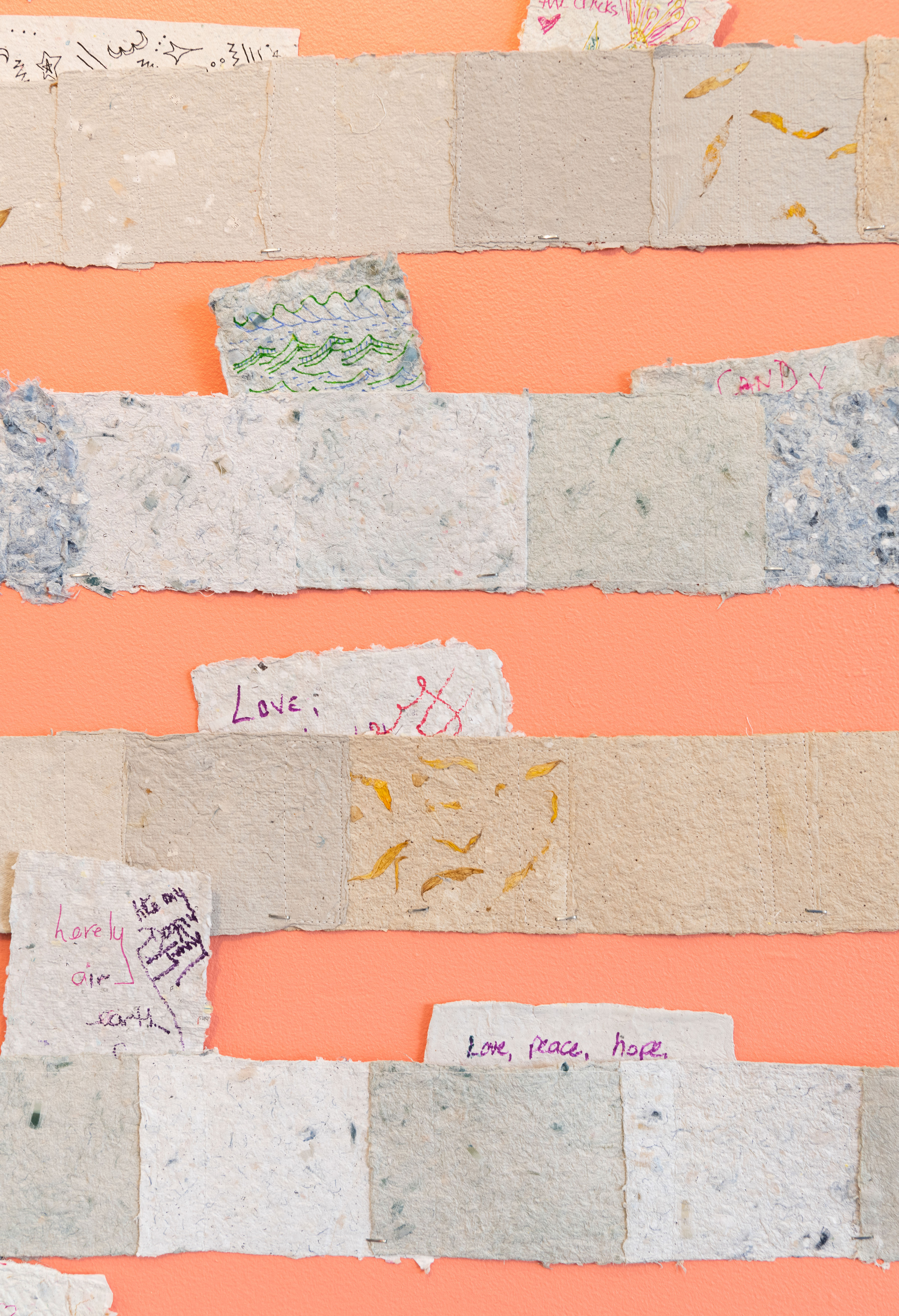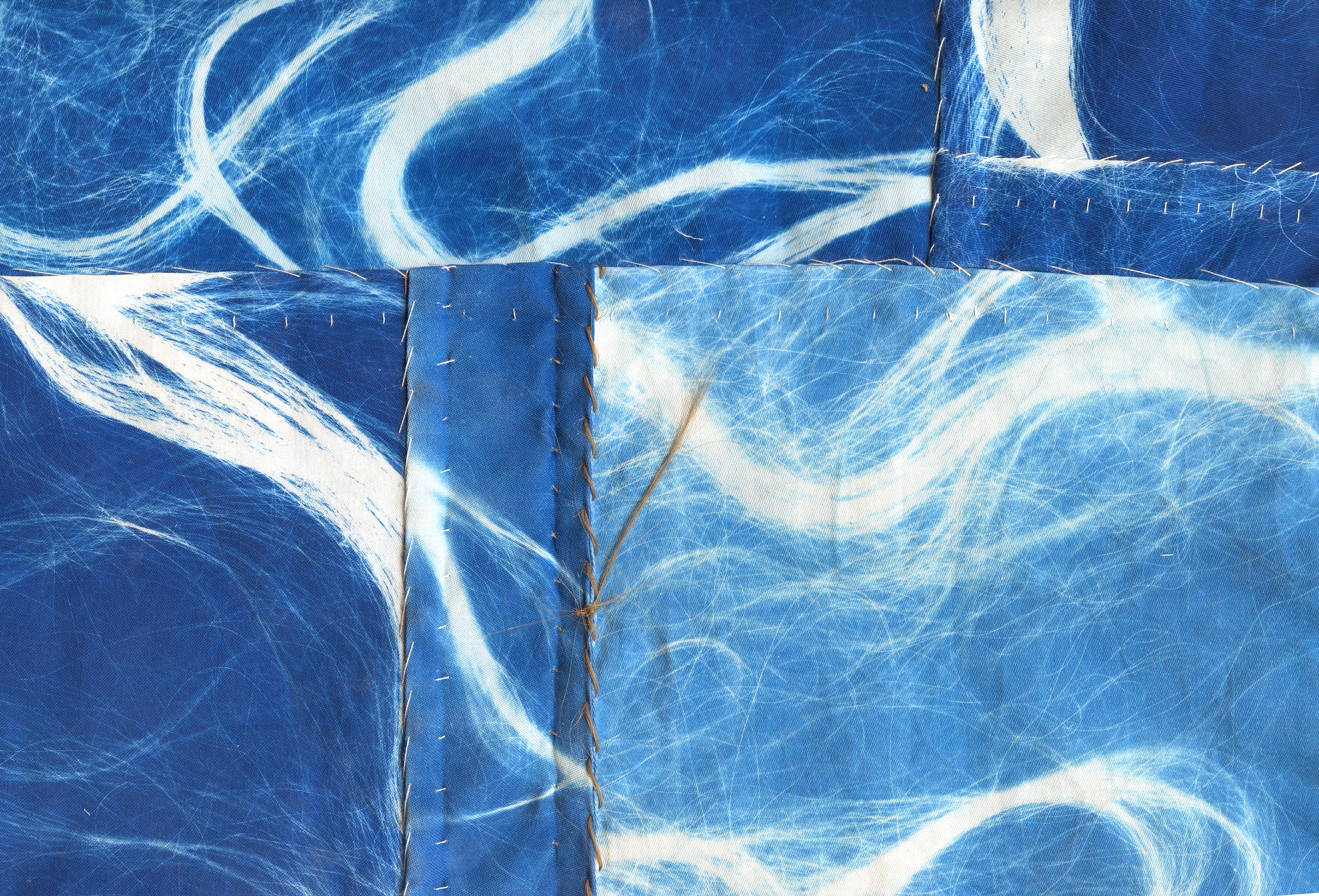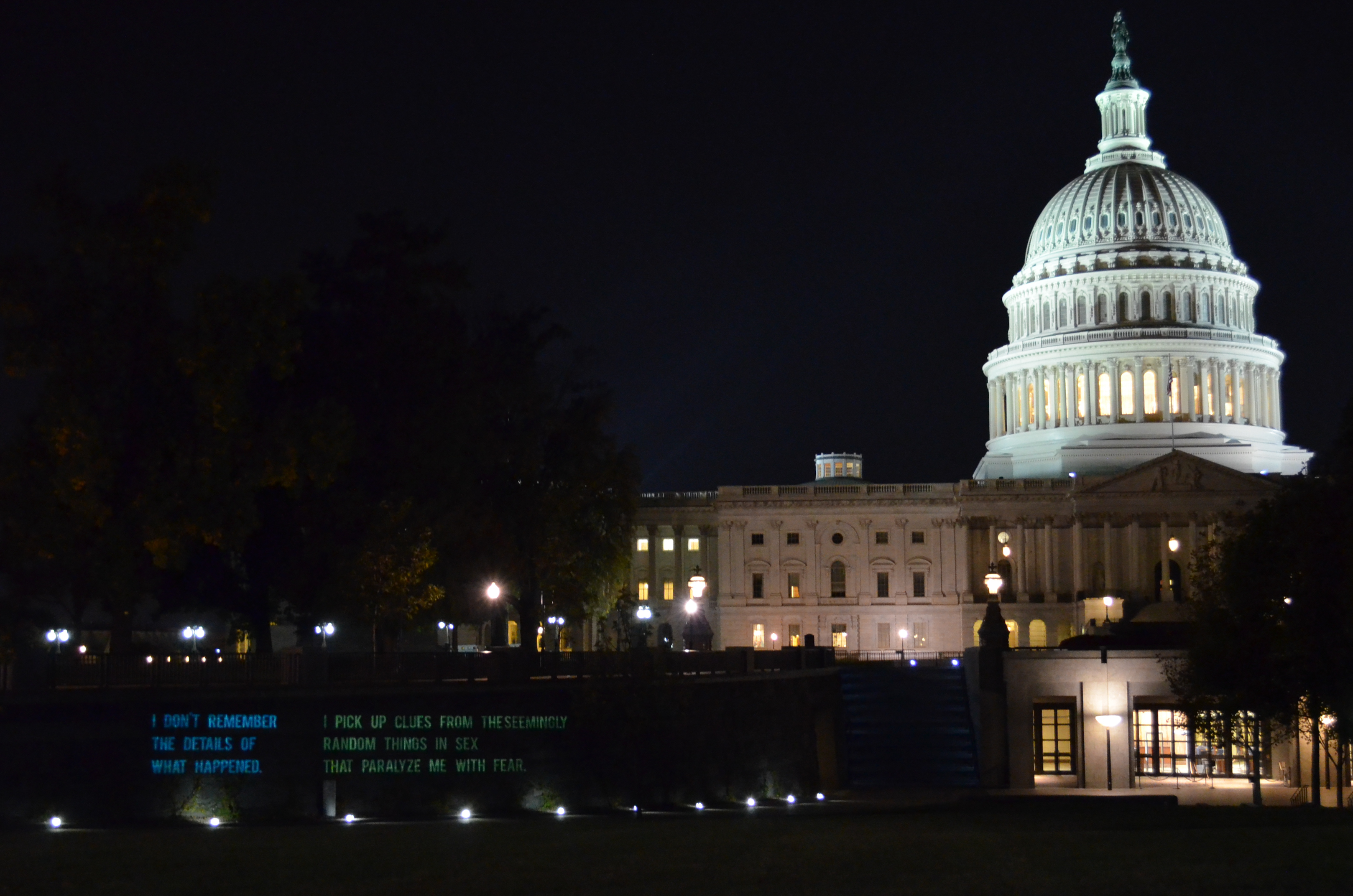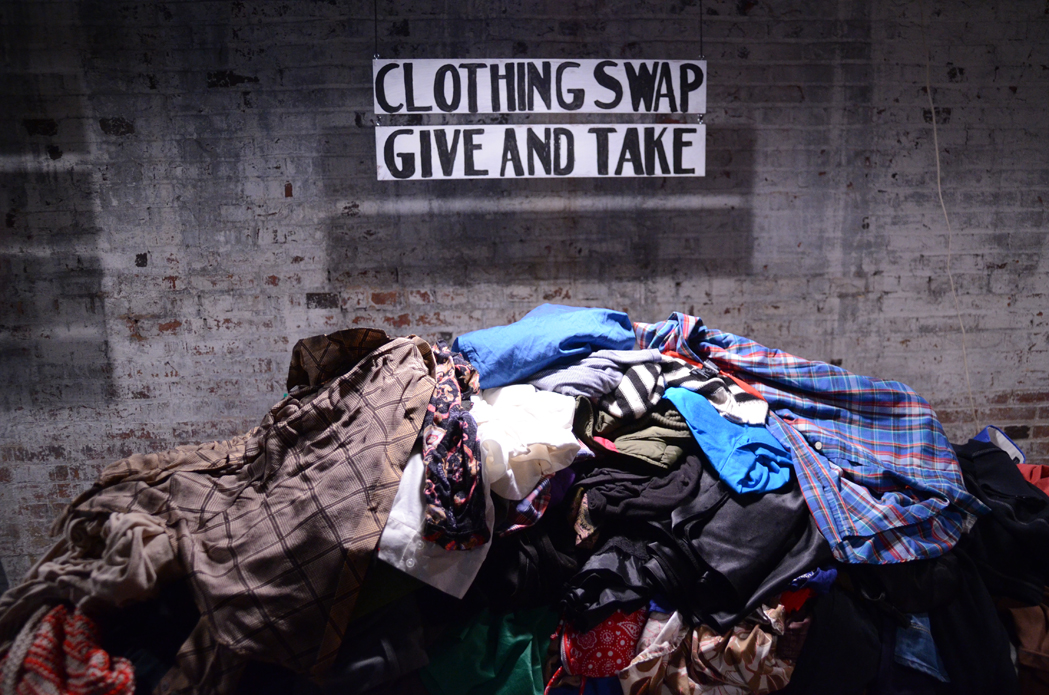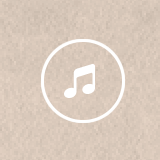Work samples
-
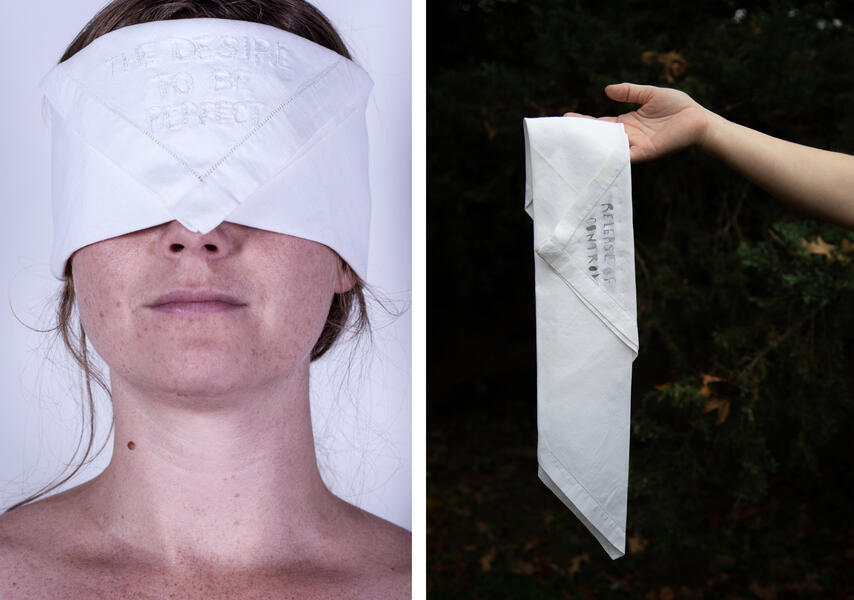 Inheritance of White SilenceInheritance of White Silence. In this project, based on my own 3 year (and lifelong) process of reflection and conversation, I am excavating the ways in which I as a white person am complicit in the system of white supremacy through internalized psychological and behavioral patterns. In Inheritance of White Silence, I embroidered a set of white linen napkins from my grandmother with symptoms of internalized white superiority. A second set was cut with statements about ways to resist these patterns, to reduce harm and also to stop the cycle in the next generation of my family.
Inheritance of White SilenceInheritance of White Silence. In this project, based on my own 3 year (and lifelong) process of reflection and conversation, I am excavating the ways in which I as a white person am complicit in the system of white supremacy through internalized psychological and behavioral patterns. In Inheritance of White Silence, I embroidered a set of white linen napkins from my grandmother with symptoms of internalized white superiority. A second set was cut with statements about ways to resist these patterns, to reduce harm and also to stop the cycle in the next generation of my family. -
 Mourning and RageOn Feb 14, 2013, as part of my creative practice with FORCE: Upsetting Rape Culture, we floated 44 giant Styrofoam letters in the reflecting pool to spell, “I CAN’T FORGET WHAT HAPPENED BUT NO ONE ELSE REMEMBERS”. The poem, which I wrote as a survivor, highlights the isolating and silencing experience of rape. The poem was a call to create a permanent memorial to survivors of rape and abuse.
Mourning and RageOn Feb 14, 2013, as part of my creative practice with FORCE: Upsetting Rape Culture, we floated 44 giant Styrofoam letters in the reflecting pool to spell, “I CAN’T FORGET WHAT HAPPENED BUT NO ONE ELSE REMEMBERS”. The poem, which I wrote as a survivor, highlights the isolating and silencing experience of rape. The poem was a call to create a permanent memorial to survivors of rape and abuse. -
The Monument Quilt on the National MallI co-founded FORCE: Upsetting Rape Culture in 2010 and was part of the collective until 2020. By and for survivors, FORCE is an art and organizing collective. Pictured here is our largest project to date, The Monument Quilt -- a collection of over 3,000 stories by survivors of sexual and intimate partner violence and our allies, painted and stitched onto red fabric. Our stories blanket highly public, outdoor places to create and demand space to heal, and resist a singular narrative about sexual violence. In June 2019, we organized the 50th and final display on the National Mall. This video tells part of the story from our weekend. Learn more: app.themonumentquilt.org
About Hannah
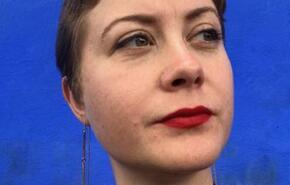
Hannah Brancato (she/her) is an artist and educator based in Baltimore, whose art practice is grounded in collective storytelling, and the creation of public rituals to bring people’s stories together. Her current practice centers on Dreamseeds, socially engaged art, music and workshop series featuring community healing spaces centered on dreaming for a more just future. For this collaborative work with Sanahara Ama Chandra, Brancato is a… more
Dreamseeds
Dreamseeds is a socially engaged art, music, and community healing space centered on dreaming for a more just future. Our installations and workshops create space to engage in reflection and conversation through written prompts, art making, and sound healing. Dreamseeds is co-created by Hannah Brancato and Sanahara Ama Chandra; the project originated with interviews with five anti-sexual violence activists.
The launch of the ongoing project was on view at Gallery CA in Baltimore, MD from October 21, 2022-November 18, 2022. Co-created by Sanahara Ama Chandra and Hannah Brancato, we started from a place of understanding that, from all of our individual and collective experiences ranging from our points of pain to our points of bliss, we have inside of us sparks of ideas that are the seeds with which we can co-create a new world.
Playing throughout this installation are a series of sound portraits created and composed by Sanahara Ama Chandra. Her lyrics and musical responses, played on crystal bowls, were improvised in response to hearing the reflections and hopes for the future brought forth by the original 5 interviewees, as well as the group conversations in a series of 6 “Journey to Dreamseeds” public workshops, which took place between June-October 2022. The original 5 interviews with Ignacio Rivera, Nuala Cabral, Alexis Flanagan, Jadelynn St Dre, and Ama Chandra, were recorded in 2021. You can listen to the sound portraits by Ama Chandra here.
In the center of the exhibition were six stitched tapestries, which are portraits of Ignacio Rivera, Nuala Cabral, Alexis Flanagan, Jadelynn St Dre, Sanahara Ama Chandra, and Hannah Brancato. Each quilt features a quote from that individual’s interview, as a wish and a piece of advice for anyone working for a more just future. The fabric was made by creating cyanotype prints using each interviewee’s hair. The process of cyanotype was originally used to reproduce blueprints. These quilts are a meditation on how the experiences of people engaged in activism results in deep wisdom that is held in our bodies; and it is an exploration of how this wisdom might serve as a blueprint for how to do social justice work in a more sustainable and visionary way.
An installation of handmade paper was installed to form a response wall, asking the question: what is your wildest dream for our future? This paper was created by workshop participants, and by Hannah Brancato, Sanahara Ama Chandra and Kendra Hebel. The question was co-written by Hannah and Ama, and the installation was designed by Hannah. In our dreamseeds workshops and throughout this exhibition, we make paper as a way of composting the old into the new. Made from ground up pieces of writing from from dozens of people, reflecting on things from the past that need to be transformed, this handmade, recycled paper is a physical representation of the ways that we can and must work with our histories, to create a new future. Visitors were invited to write or draw their own response, to add to the weaving.
-
 Dreamseeds - Installation View
Dreamseeds - Installation ViewDreamseeds is a socially engaged art, music, and community healing space centered on dreaming for a more just future. Our installations and workshops create space to engage in reflection and conversation through written prompts, art making, and sound healing. Dreamseeds is co-created by Hannah Brancato and Sanahara Ama Chandra; the project originated with interviews with five anti-sexual violence activists.
The launch of the ongoing project was on view at Gallery CA in Baltimore, MD from October 21, 2022-November 18, 2022. Co-created by Sanahara Ama Chandra and Hannah Brancato, we started from a place of understanding that, from all of our individual and collective experiences ranging from our points of pain to our points of bliss, we have inside of us sparks of ideas that are the seeds with which we can co-create a new world. The exhibition featured sound portraits by Ama Chandra, quilted portraits by Hannah Brancato featured quotes by five activists, an interactive installation and response wall featuring handmade paper, made by the collaborative duo, and a workshop series.
-
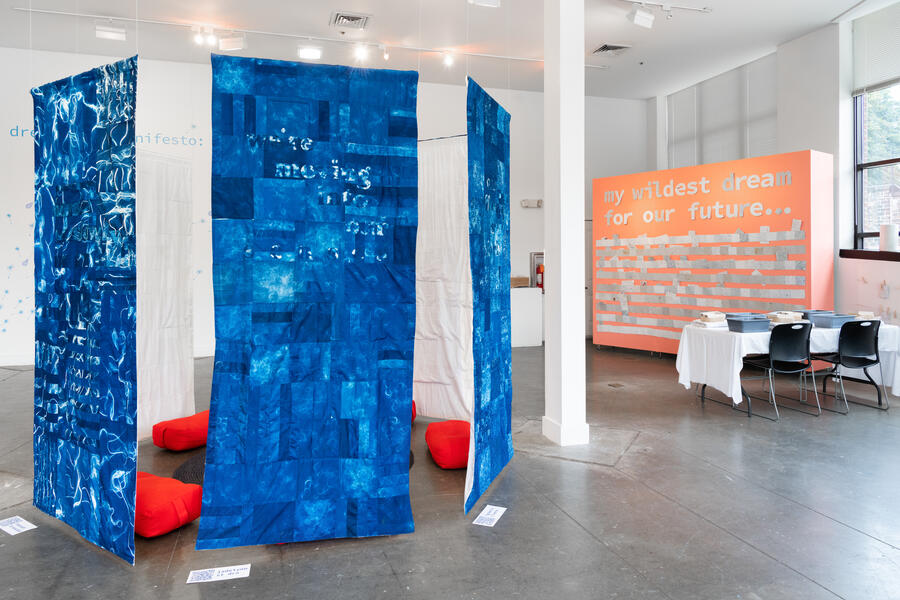 Dreamseeds - Installation View
Dreamseeds - Installation View -
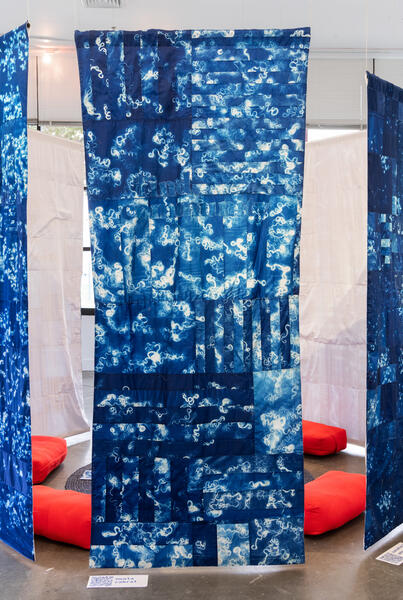 Detail view - Move Slowly Tapestry
Detail view - Move Slowly Tapestry -
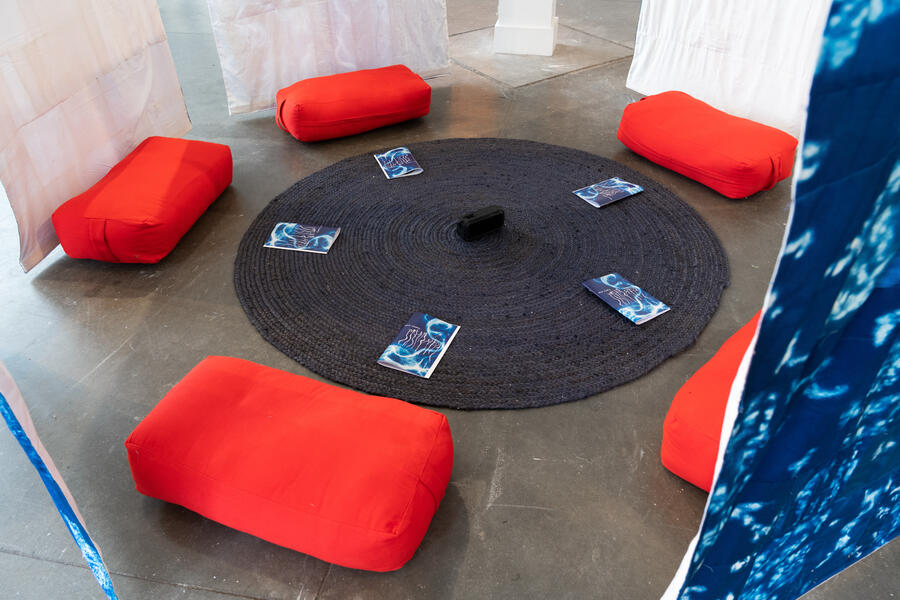 Move Slowly Listening Circle
Move Slowly Listening Circle -
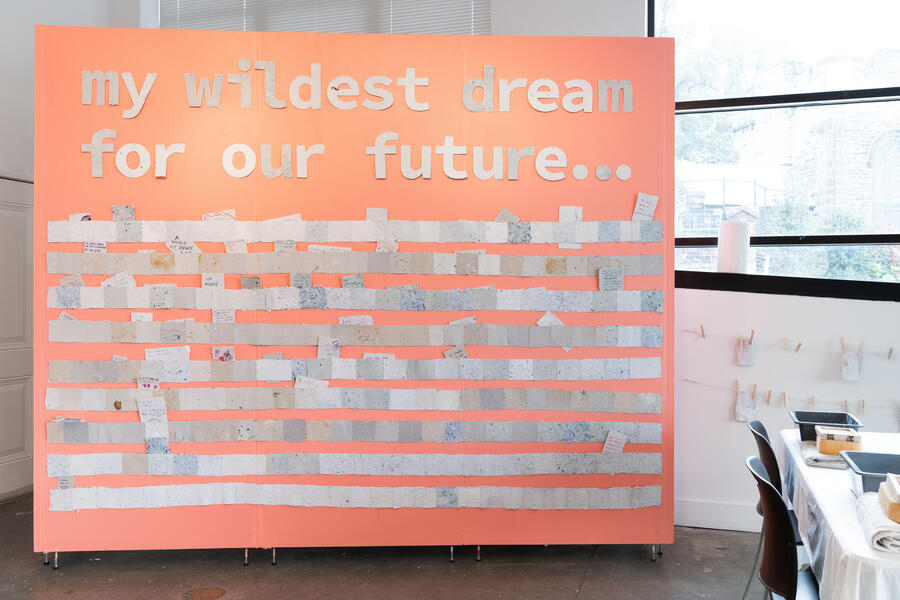 what is your wildest dream for our future?
what is your wildest dream for our future?An installation of handmade paper was installed to form a response wall, asking the question: what is your wildest dream for our future? This paper was created by workshop participants, and by Hannah Brancato, Sanahara Ama Chandra and Kendra Hebel. The question was co-written by Hannah and Ama, and the installation was designed by Hannah. In our dreamseeds workshops and throughout this exhibition, we make paper as a way of composting the old into the new. Made from ground up pieces of writing from from dozens of people, reflecting on things from the past that need to be transformed, this handmade, recycled paper is a physical representation of the ways that we can and must work with our histories, to create a new future. Visitors were invited to write or draw their own response, to add to the weaving.
-
 your wildest dream - detail view
your wildest dream - detail view -
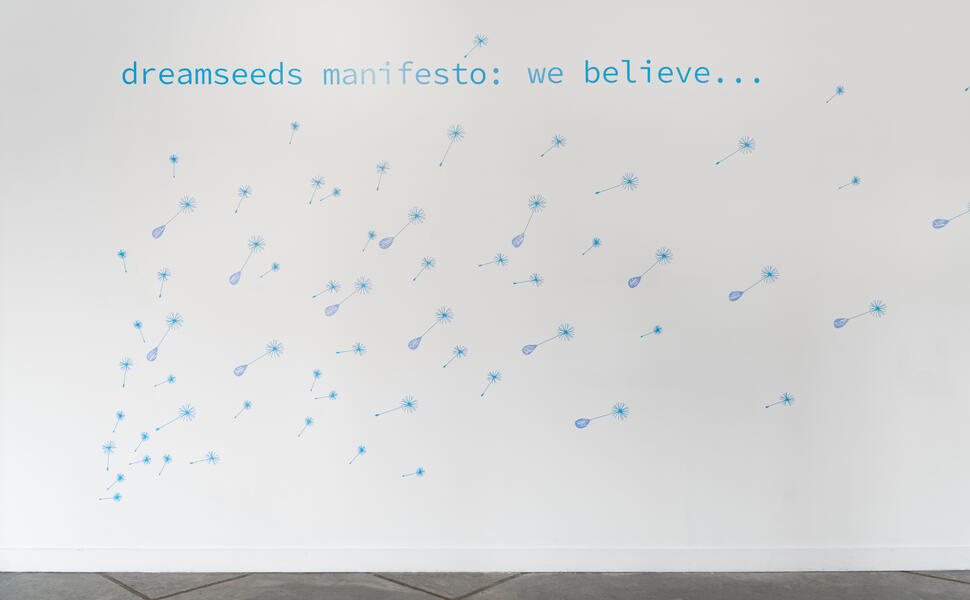 Dreamseeds Manifesto
Dreamseeds Manifesto -
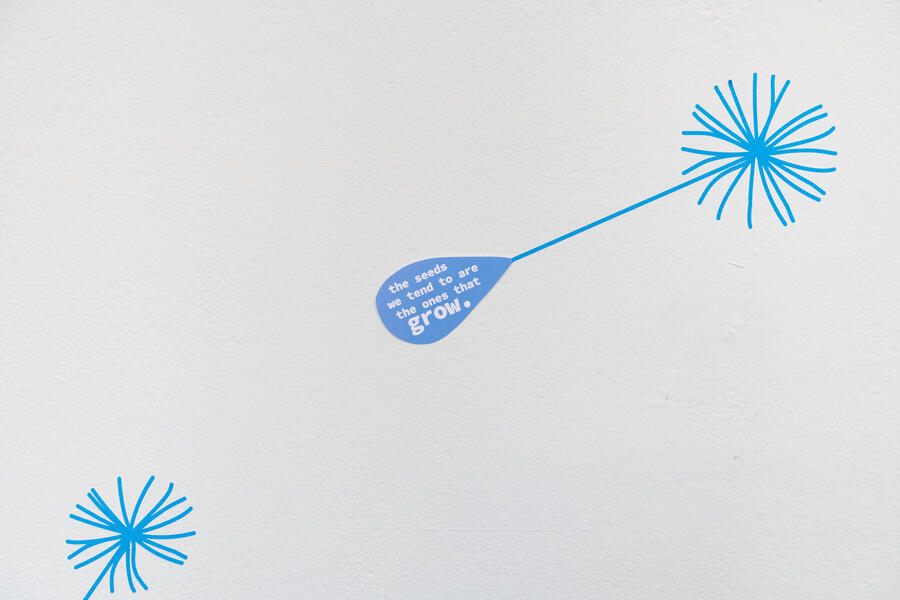 Dreamseeds Manifesto Detail
Dreamseeds Manifesto Detail -
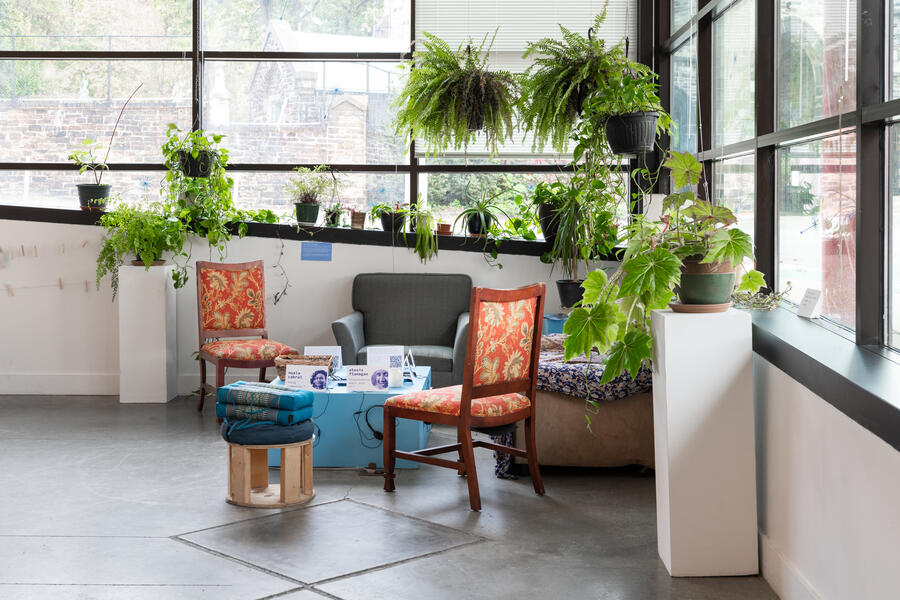 Listening area - Move Slowly interviews
Listening area - Move Slowly interviewsHouseplants and comfortable chairs are arranged in a circle, with headphones where visitors can listen to the Move Slowly interviews.
-
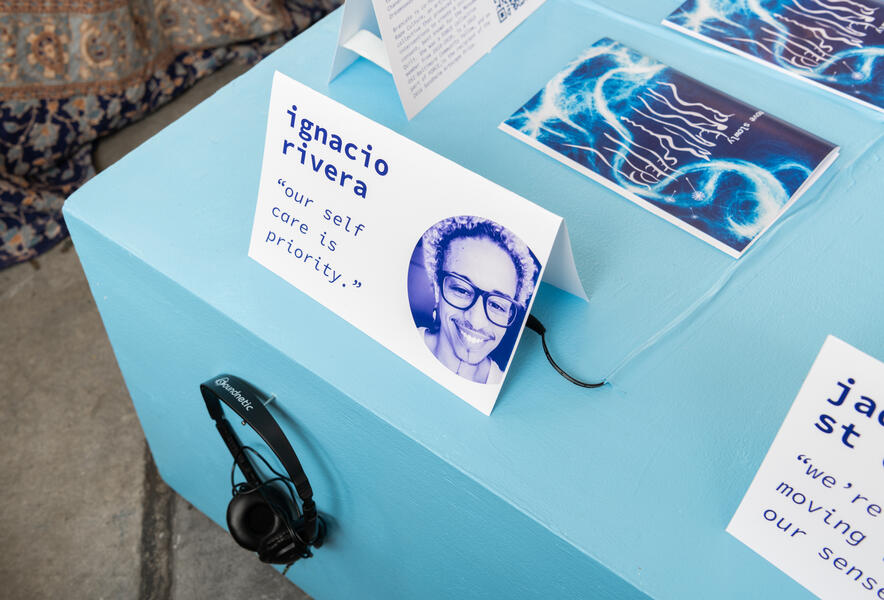 Listening Corner, detail view
Listening Corner, detail view
Inheritance of White Silence
In this project, based on my own 3 year (and lifelong) process of reflection and conversation, I am excavating the ways in which I as a white person am complicit in the system of white supremacy through internalized psychological and behavioral patterns. In Inheritance of White Silence, I embroidered a set of white linen napkins from my grandmother with symptoms of internalized white superiority. A second set was cut with statements about ways to resist these patterns, to reduce harm and also to stop the cycle in the next generation of my family.
The premise of the project is that in addition to material benefits, there is a psychology of white superiority that is unavoidable for anyone in America, and that we need more avenues to understand and uproot it; and that alongside structural and financial reparations, investigating and undoing this legacy is crucial to disrupting and ultimately ending the caste system of race that we live within.
Photography by Tanya Garcia
-
 Inheritance of White Silence - Self Portrait
Inheritance of White Silence - Self Portrait -
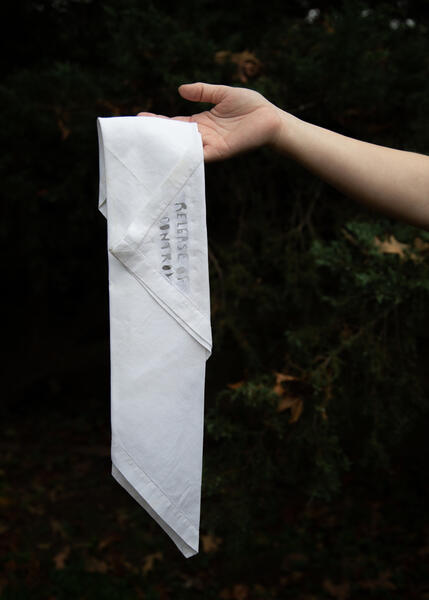 Inheritance of White Silence - Release of ControlInheritance of White Silence. In this project, based on my own 3 year (and lifelong) process of reflection and conversation, I am excavating the ways in which I as a white person am complicit in the system of white supremacy through internalized psychological and behavioral patterns. In Inheritance of White Silence, I embroidered a set of white linen napkins from my grandmother with symptoms of internalized white superiority. A second set (pictured here) was cut with statements about ways to resist these patterns, to reduce harm and also to stop the cycle in the next generation of my family. This cut piece, which says "Release of control," is paired withe the embroidered statement "The Desire To Be Perfect." The premise of the project is that in addition to material benefits, there is a psychology of white superiority that is unavoidable for anyone in America, and that we need more avenues to understand and uproot it; and that alongside structural and financial reparations, investigating and undoing this legacy is crucial to disrupting and ultimately ending the caste system of race that we live within. Photography by Tanya Garcia
Inheritance of White Silence - Release of ControlInheritance of White Silence. In this project, based on my own 3 year (and lifelong) process of reflection and conversation, I am excavating the ways in which I as a white person am complicit in the system of white supremacy through internalized psychological and behavioral patterns. In Inheritance of White Silence, I embroidered a set of white linen napkins from my grandmother with symptoms of internalized white superiority. A second set (pictured here) was cut with statements about ways to resist these patterns, to reduce harm and also to stop the cycle in the next generation of my family. This cut piece, which says "Release of control," is paired withe the embroidered statement "The Desire To Be Perfect." The premise of the project is that in addition to material benefits, there is a psychology of white superiority that is unavoidable for anyone in America, and that we need more avenues to understand and uproot it; and that alongside structural and financial reparations, investigating and undoing this legacy is crucial to disrupting and ultimately ending the caste system of race that we live within. Photography by Tanya Garcia -
 Inheritance of White Silence - Feeling There is Never Enough
Inheritance of White Silence - Feeling There is Never Enough -
 Inheritance of White Silence - The Vision to See Abundance
Inheritance of White Silence - The Vision to See Abundance -
 Inheritance of White Silence - Disconnection From My Roots
Inheritance of White Silence - Disconnection From My Roots -
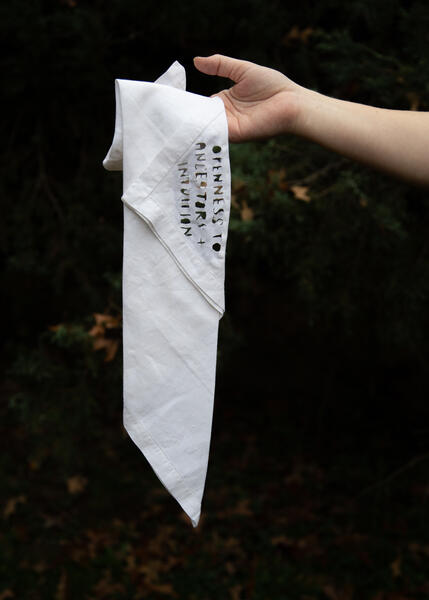 Inheritance of White Silence / Openness to Ancestors and Intuition
Inheritance of White Silence / Openness to Ancestors and Intuition -
 Inheritance of White Silence - A Need to Be Seen As "Good"
Inheritance of White Silence - A Need to Be Seen As "Good" -
 Inheritance of White Silence - The Courage to Resist Injustice
Inheritance of White Silence - The Courage to Resist Injustice -
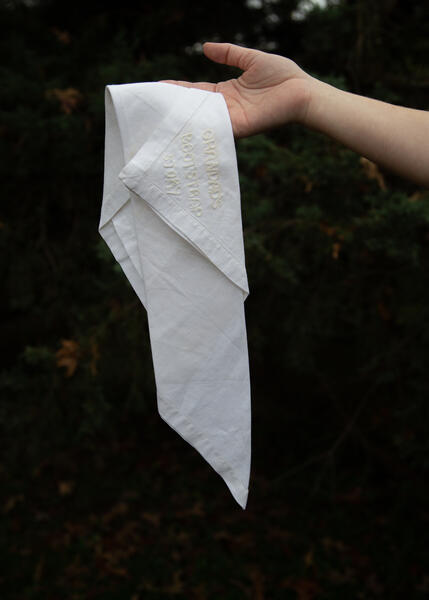 Inheritance of White Silence - Grandad's Bootstrap Story
Inheritance of White Silence - Grandad's Bootstrap Story -
 Inheritance of White Silence - An Understanding of Interdependence
Inheritance of White Silence - An Understanding of Interdependence
Dreamscape
-
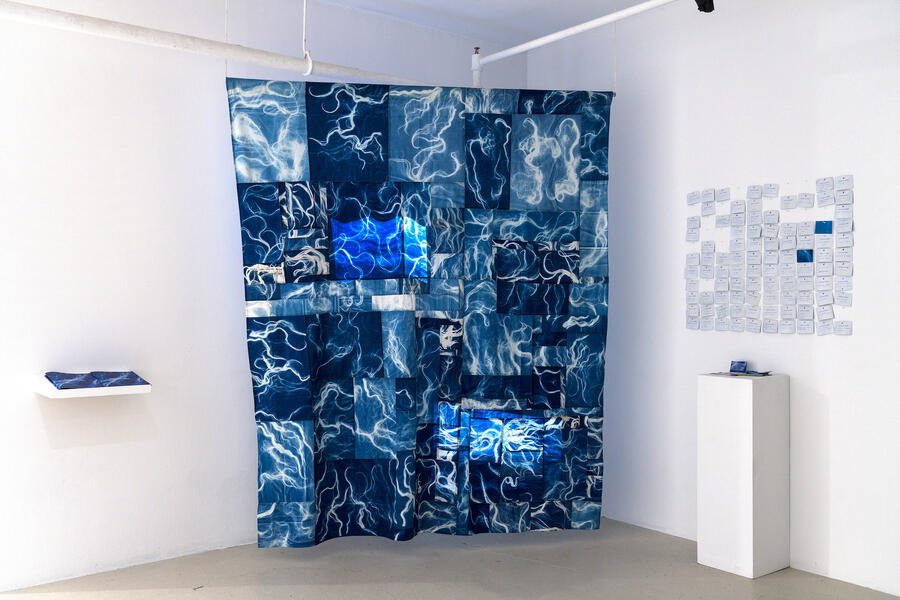 Dreamscape - Installation ViewThis installation includes a hand-stitched tapestry of cyanotype prints of my own hair, embroidered with segments from my dreams, also using hair. To the left, viewers were invited to view the artist book. To the right, viewers were invited to respond the theme of change in their own lives, and how it relates to “dreams.”
Dreamscape - Installation ViewThis installation includes a hand-stitched tapestry of cyanotype prints of my own hair, embroidered with segments from my dreams, also using hair. To the left, viewers were invited to view the artist book. To the right, viewers were invited to respond the theme of change in their own lives, and how it relates to “dreams.” -
 Dreamscape - Tapestry DetailDreamscape is an installation featuring stitched-together cyanotypes of my hair, adorned with embroideries from my dreams, along with a zine and an interactive space. Dreamscape served as a space of exploration about change, transitions, and the sense of self that, for me, is attached to my dreams -- both the aspirations I have for my life, and my subconscious. The zine is filled with meditations that I have found helpful during this time of transition, and an interactive space for visitors to reflect on their own experiences with change.
Dreamscape - Tapestry DetailDreamscape is an installation featuring stitched-together cyanotypes of my hair, adorned with embroideries from my dreams, along with a zine and an interactive space. Dreamscape served as a space of exploration about change, transitions, and the sense of self that, for me, is attached to my dreams -- both the aspirations I have for my life, and my subconscious. The zine is filled with meditations that I have found helpful during this time of transition, and an interactive space for visitors to reflect on their own experiences with change. -
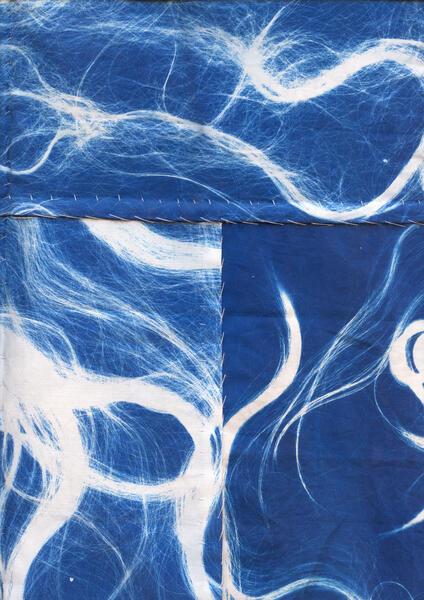 Dreamscape - Tapestry Detail
Dreamscape - Tapestry Detail -
 Dreamscape - Artist Book
Dreamscape - Artist Book -
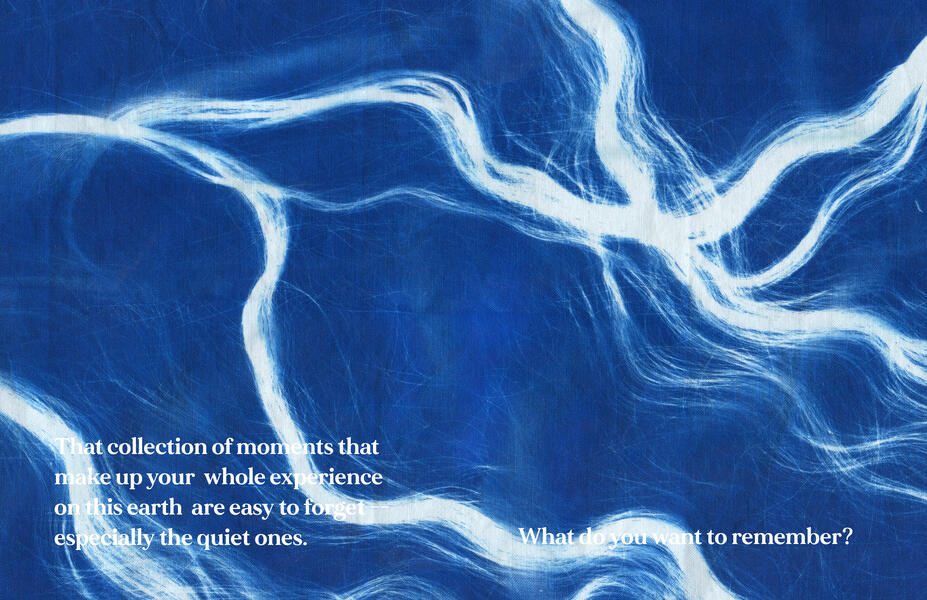 Dreamscape - Artist Book detail
Dreamscape - Artist Book detail -
 Dreamscape - Artist Book detail
Dreamscape - Artist Book detail -
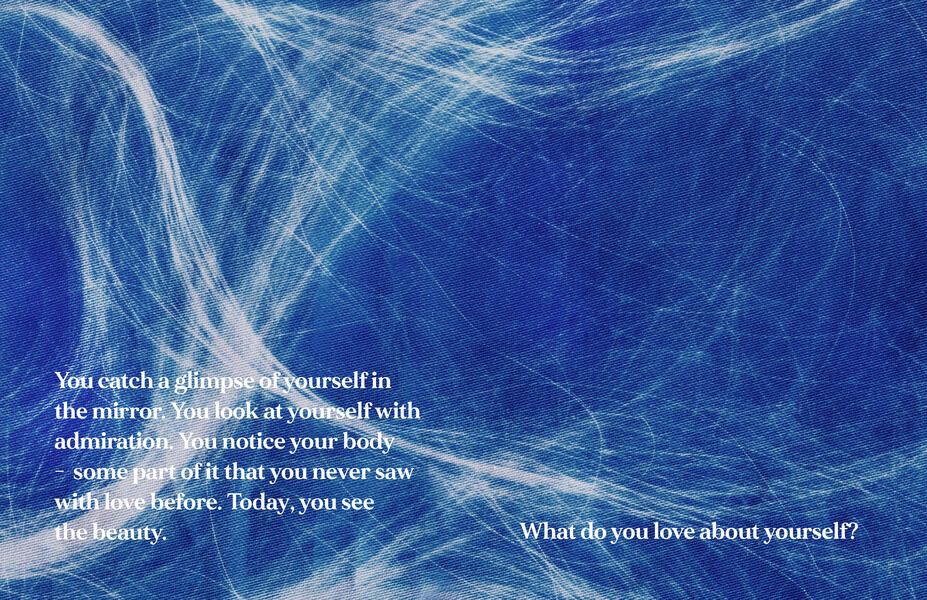 Dreamscape - Artist Book detail
Dreamscape - Artist Book detail -
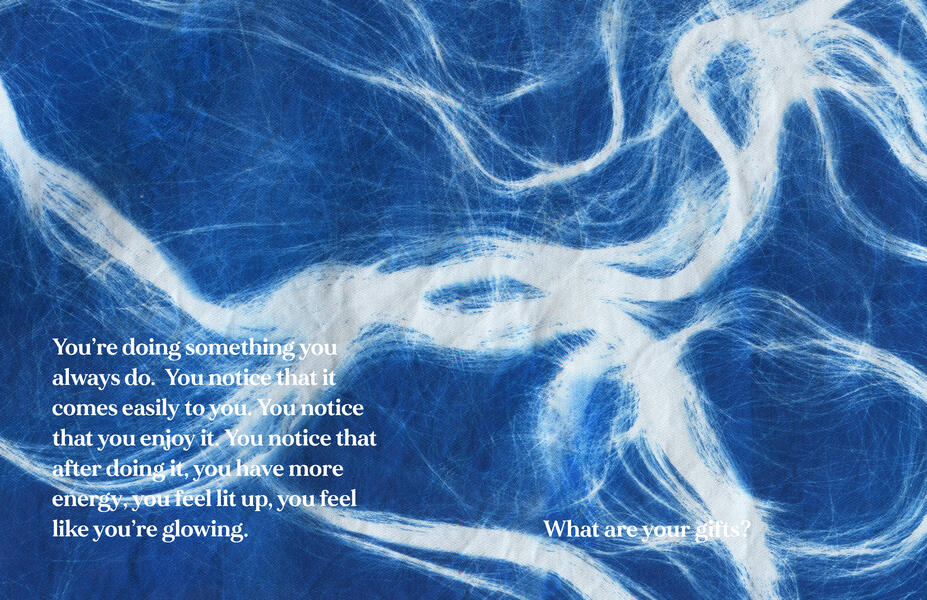 Dreamscape - Artist Book detail
Dreamscape - Artist Book detail -
 Dreamscape - Artist Book detail
Dreamscape - Artist Book detail
Monument to Resistance
Fredrick Douglass wrote about how imagining himself as a free man, and seeing enslavement as a temporary injustice that must be changed, was to resist bondage. “From my earliest recollection, I date the deep conviction that slavery would not always be able to hold me within its foul embrace.” He describes how this conviction created hope, the possibility of joy, and provided an explanation for the deep sorrow he often felt. He writes about how the gospel songs of enslaved people were an expression of these complex feelings: “Every tone was a testimony against slavery, and a prayer to God for deliverance from chains.”
Oluale Kossola’s oral history led me to the words “truth-telling” and “story-telling.” Kossola was the last living survivor of the trans-Atlantic slave trade from West Africa to the US. When Zora Neale Hurston interviewed him in 1927, he recalled detailed memories of the torture, violence and abuse he endured while enslaved. His ability to share this testimony decades later meant that he could tell the world about the injustice done to him. It also meant that he remembered his ancestors, his culture, and what it was like to be free, and that he passed this memory on to those around him, and now to those who can read his story.
-
Resistance Monument - front viewThis piece was commissioned by, and donated to, the Benjamin Banneker Museum. It honors Benjamin’s father, Robert Bannaky, and his resistance to and escape from slavery. In this intimate monument, embroidered words honor the variety of ways that resistance manifests, offering a chance for you as a viewer and me as an artist to reflect on the less obvious forms that it can take. Since Robert Bannaky did not write his own story, to choose these words, I relied on the writing and oral history of two other people who were enslaved in the US: Fredrick Douglass, and Oluale Kossola, also known as Cudjo Lewis.
-
Resistance Monument - back viewThis piece was commissioned by, and donated to, the Benjamin Banneker Museum. It honors Benjamin’s father, Robert Bannaky, and his resistance to and escape from slavery. In this intimate monument, embroidered words honor the variety of ways that resistance manifests, offering a chance for you as a viewer and me as an artist to reflect on the less obvious forms that it can take. Since Robert Bannaky did not write his own story, to choose these words, I relied on the writing and oral history of two other people who were enslaved in the US: Fredrick Douglass, and Oluale Kossola, also known as Cudjo Lewis.
-
Resistance Monument - detailThis piece was commissioned by, and donated to, the Benjamin Banneker Museum. It honors Benjamin’s father, Robert Bannaky, and his resistance to and escape from slavery. In this intimate monument, embroidered words honor the variety of ways that resistance manifests, offering a chance for you as a viewer and me as an artist to reflect on the less obvious forms that it can take. Since Robert Bannaky did not write his own story, to choose these words, I relied on the writing and oral history of two other people who were enslaved in the US: Fredrick Douglass, and Oluale Kossola, also known as Cudjo Lewis.
FORCE: Upsetting Rape Culture
Members of the FORCE staff collective shaped the vision of the Monument Quilt, and it was guided by FORCE’s Leadership Team. The staff collective currently includes Charnell Covert, E Cadoux, Mora Fernández, Hannah Brancato, and Shanti Flagg. Former staff collective members include Saida Agostini, Robin Marquis and Rebecca Nagle. The Monument Quilt was co-founded by Hannah Brancato and Rebecca Nagle in 2013. The Leadership Team currently includes Amber Melvin, Alexis Flanagan, Greg Grey Cloud, Jacob Simpson, Jadelynn Stahl, JP Przewoznik, Dr. Kalima Young, Kate Bishop, Leigh Ann Sham, Liz Ensz, Lorena Kourousias, Norwood Johnson, Rachel Gilmer, and Winter Miller.
The Monument Quilt was launched in 2013, and over the past six years, FORCE collected nearly 3,000 squares of the quilt with messages of affirmation and stories from survivors. We’ve partnered with over 100 organizations across the US and in Mexico, to organize 50 Quilt displays in 33 different cities. Cities include, in order from most recent: Washington, DC; Baltimore, MD; Madison, NJ; Houston, TX; Athens, OH; Fort Belvoir, VA; Towson, MD; Mexico City, Mexico; San Francisco, CA; El Paso, TX; Ciudad Juárez, Mexico; Santa Barbara, CA; Valley Center, CA; Tempe, AZ; Tulsa, OK; Fort Hood, TX; Annapolis, MD; Fort Meade, MD; Washington, DC; Nashville, TN; Jacksonville, FL; Oklahoma City, OK; Middleton, CT; Queens, NY; Pittsburgh, PA; Durham, NC; Oshkosh, WI; Chicago, IL; White River, SD; Quapaw, OK; Des Moines, IA; Baton Rouge, LA; Birmingham, AL; Arden, NC.
-
 The Monument QuiltThe final display of the Monument Quilt on the National Mall, May 31-June 2, 2019. This was the 50th display and it featured over 3,000 stories from survivors.
The Monument QuiltThe final display of the Monument Quilt on the National Mall, May 31-June 2, 2019. This was the 50th display and it featured over 3,000 stories from survivors. -
The Monument Quilt on the National MallI co-founded FORCE: Upsetting Rape Culture in 2010 and was part of the collective until 2020. By and for survivors, FORCE is an art and organizing collective. Pictured here is our largest project to date, The Monument Quilt -- a collection of over 3,000 stories by survivors of sexual and intimate partner violence and our allies, painted and stitched onto red fabric. Our stories blanket highly public, outdoor places to create and demand space to heal, and resist a singular narrative about sexual violence. In June 2019, we organized the 50th and final display on the National Mall. This video tells part of the story from our weekend. Learn more: app.themonumentquilt.org
-
History of the Monument QuiltThe Monument Quilt, a project of Baltimore based FORCE: Upsetting Rape Culture, is a collection of over 3,000 stories by survivors of sexual and intimate partner violence and our allies, written, painted, and stitched onto red fabric. Our stories literally blanket highly public, outdoor places to create and demand space to heal, and resist a singular narrative about sexual violence. The culminating display is coming up May 31 – June 2, 2019, on the National Mall in Washington, DC. This will be the only time that the quilt will be viewed in its entirety. The project has received national coverage through MSNBC and Refinery 29, including of our art actions at Standing Rock and in solidarity with Marissa Alexander. We continue to receive local coverage during Monument Quilt workshops and events organized by our partners, such as this article in the Alton Telegraph.
-
 Mourning and RageOn Feb 14, 2013, as part of my creative practice with FORCE: Upsetting Rape Culture, we floated 44 giant Styrofoam letters in the reflecting pool to spell, “I CAN’T FORGET WHAT HAPPENED BUT NO ONE ELSE REMEMBERS”. The poem, which I wrote as a survivor, highlights the isolating and silencing experience of rape. The poem was a call to create a permanent memorial to survivors of rape and abuse.
Mourning and RageOn Feb 14, 2013, as part of my creative practice with FORCE: Upsetting Rape Culture, we floated 44 giant Styrofoam letters in the reflecting pool to spell, “I CAN’T FORGET WHAT HAPPENED BUT NO ONE ELSE REMEMBERS”. The poem, which I wrote as a survivor, highlights the isolating and silencing experience of rape. The poem was a call to create a permanent memorial to survivors of rape and abuse. -
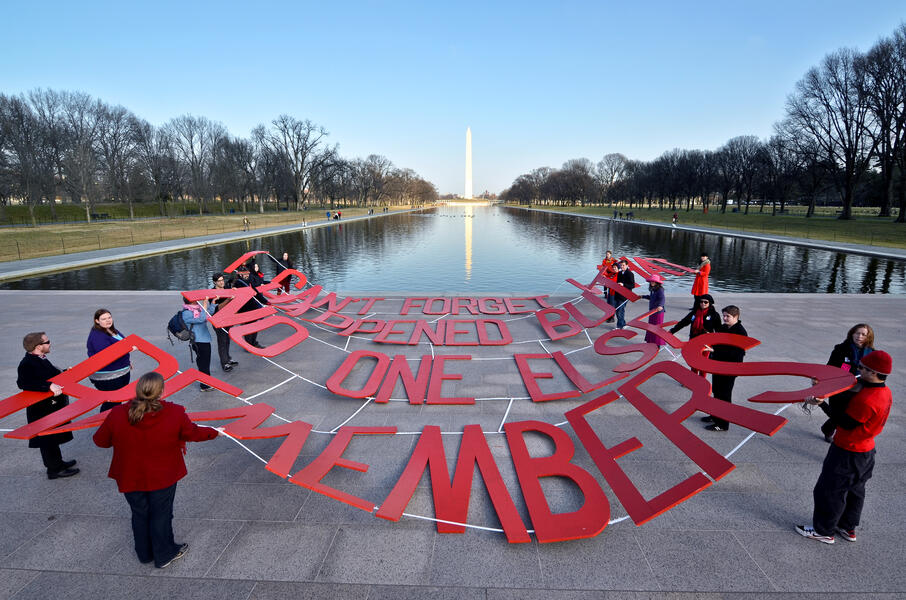 13-MourningAndRage.jpgOn Feb 14, 2013, FORCE: Upsetting Rape Culture floated 44 giant Styrofoam letters in the reflecting pool to spell, “I CAN’T FORGET WHAT HAPPENED BUT NO ONE ELSE REMEMBERS”. The poem, which I wrote as a survivor, highlights the isolating and silencing experience of rape in the United States. The poem was a call to create a permanent memorial to survivors of rape and abuse.
13-MourningAndRage.jpgOn Feb 14, 2013, FORCE: Upsetting Rape Culture floated 44 giant Styrofoam letters in the reflecting pool to spell, “I CAN’T FORGET WHAT HAPPENED BUT NO ONE ELSE REMEMBERS”. The poem, which I wrote as a survivor, highlights the isolating and silencing experience of rape in the United States. The poem was a call to create a permanent memorial to survivors of rape and abuse. -
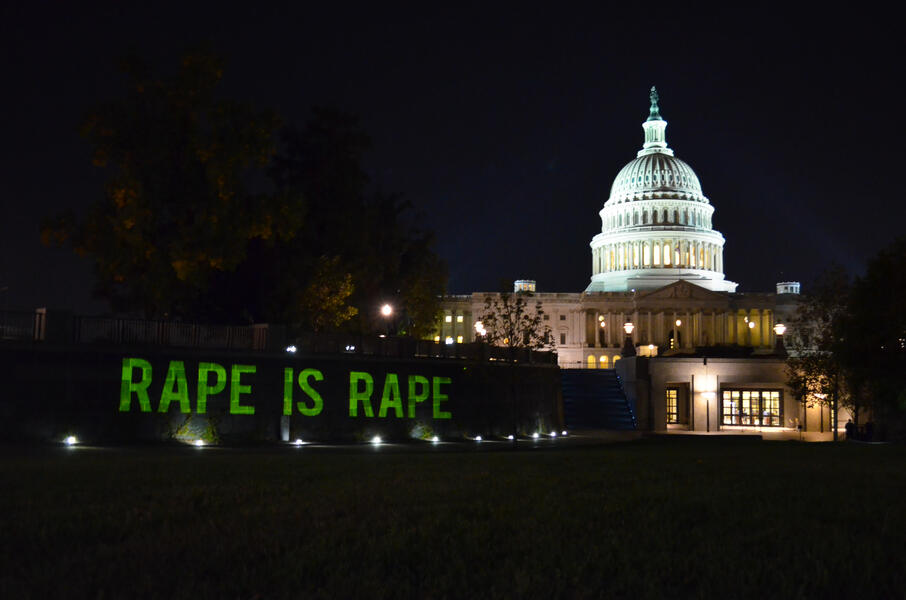 Rape is RapeIn 2012, FORCE: Upsetting Rape Culture projected “RAPE is RAPE onto the US Capitol Building with stories of survivors during the 2012 national election. The stories fell outside of the definition of “forcible rape” and illuminate what is missing from the national conversation on the politics of rape: the experience of survivors. The demonstration was carried off in collaboration with Luminous Intervention.
Rape is RapeIn 2012, FORCE: Upsetting Rape Culture projected “RAPE is RAPE onto the US Capitol Building with stories of survivors during the 2012 national election. The stories fell outside of the definition of “forcible rape” and illuminate what is missing from the national conversation on the politics of rape: the experience of survivors. The demonstration was carried off in collaboration with Luminous Intervention. -
 Rape is RapeIn 2012, FORCE: Upsetting Rape Culture projected “RAPE is RAPE onto the US Capitol Building with stories of survivors during the 2012 national election. The stories fell outside of the definition of “forcible rape” and illuminate what is missing from the national conversation on the politics of rape: the experience of survivors. The demonstration was carried off in collaboration with Luminous Intervention. This slide states: “I don’t remember the details of what happened. I pick up clues from the seemingly random things in sex that paralyze me with fear.”
Rape is RapeIn 2012, FORCE: Upsetting Rape Culture projected “RAPE is RAPE onto the US Capitol Building with stories of survivors during the 2012 national election. The stories fell outside of the definition of “forcible rape” and illuminate what is missing from the national conversation on the politics of rape: the experience of survivors. The demonstration was carried off in collaboration with Luminous Intervention. This slide states: “I don’t remember the details of what happened. I pick up clues from the seemingly random things in sex that paralyze me with fear.” -
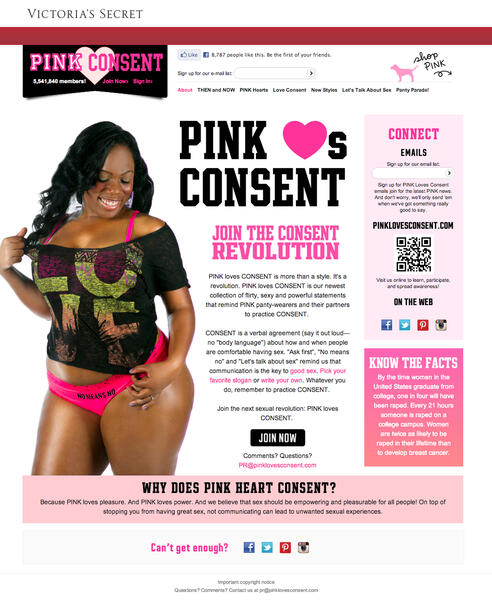 PINK loves CONSENT- About Page“PINK loves CONSENT” was a web-based prank that made consent go viral and sparked an internet revolution. FORCE pretended to be Victoria’s Secret promoting a new line of consent-themed, anti-rape panties. The action and internet aftermath got millions of people talking about consent, rape culture, and the sexual empowerment of women. This is the home page. The website was designed by Dan Staples, and the photography is by Philip Laubner. "PINK loves CONSENT is more than a style. It's a revolution. PINK loves CONSENT is our newest collection of flirty, sexy and powerful statements that remind PINK panty-wearers and their partners to practice CONSENT. From the page: "CONSENT is a verbal agreement (say it out loud—no "body language") about how and when people are comfortable having sex. "Ask first", "No means no" and "Let's talk about sex" remind us that communication is the key to good sex. Pick your favorite slogan or write your own. Whatever you do, remember to practice CONSENT. Join the next sexual revolution: PINK loves CONSENT. " pinklovesconsent.com
PINK loves CONSENT- About Page“PINK loves CONSENT” was a web-based prank that made consent go viral and sparked an internet revolution. FORCE pretended to be Victoria’s Secret promoting a new line of consent-themed, anti-rape panties. The action and internet aftermath got millions of people talking about consent, rape culture, and the sexual empowerment of women. This is the home page. The website was designed by Dan Staples, and the photography is by Philip Laubner. "PINK loves CONSENT is more than a style. It's a revolution. PINK loves CONSENT is our newest collection of flirty, sexy and powerful statements that remind PINK panty-wearers and their partners to practice CONSENT. From the page: "CONSENT is a verbal agreement (say it out loud—no "body language") about how and when people are comfortable having sex. "Ask first", "No means no" and "Let's talk about sex" remind us that communication is the key to good sex. Pick your favorite slogan or write your own. Whatever you do, remember to practice CONSENT. Join the next sexual revolution: PINK loves CONSENT. " pinklovesconsent.com
Cut Pieces
-
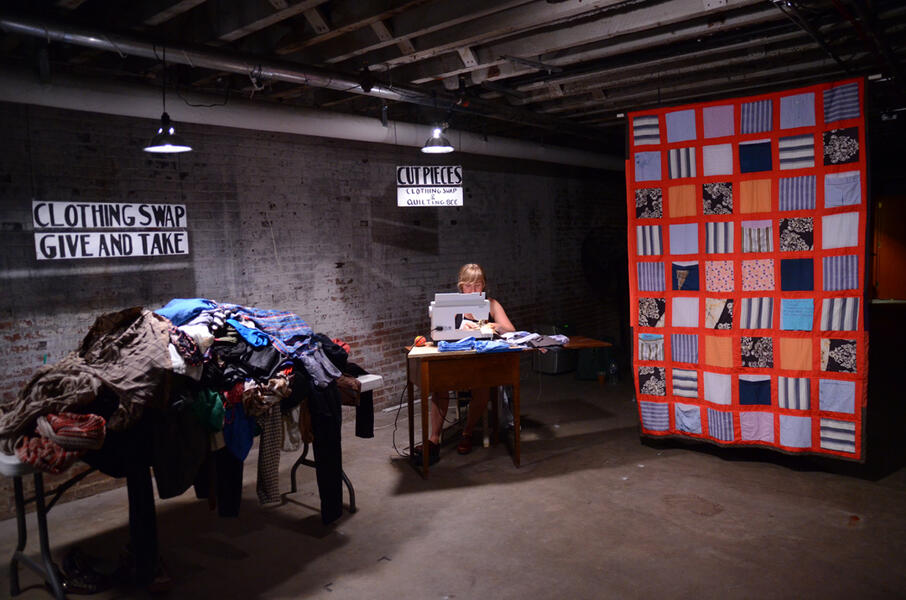 Cut PiecesFor the exhibition Down Through the Needle's Eye, Hannah Brancato and Charlotte Keniston created a space for a clothing swap, fostering interaction and a consciousness about consumption. Stained or otherwise un-wearable garments were cut up and stitched together by the artists to create quilts in the gallery during workshop days throughout the exhibition. When people submitted garments for the quilt they wrote a few sentences about the garment's history- where did it come from? When did you wear it? How long did you have it? Pockets throughout the quilts hold transcriptions of these stories.
Cut PiecesFor the exhibition Down Through the Needle's Eye, Hannah Brancato and Charlotte Keniston created a space for a clothing swap, fostering interaction and a consciousness about consumption. Stained or otherwise un-wearable garments were cut up and stitched together by the artists to create quilts in the gallery during workshop days throughout the exhibition. When people submitted garments for the quilt they wrote a few sentences about the garment's history- where did it come from? When did you wear it? How long did you have it? Pockets throughout the quilts hold transcriptions of these stories. -
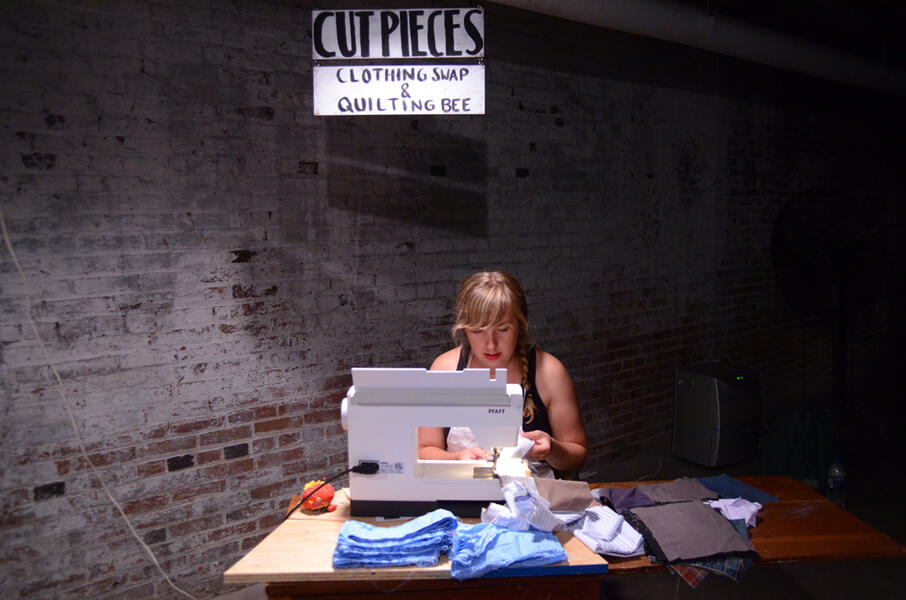 Cut Pieces - sewing viewDuring the performance, we stitched together the stories in the gallery space. For the exhibition Down Through the Needle's Eye, Hannah Brancato and Charlotte Keniston created a space for a clothing swap, fostering interaction and a consciousness about consumption. Stained or otherwise un-wearable garments were cut up and stitched together by the artists to create quilts in the gallery during workshop days throughout the exhibition. When people submitted garments for the quilt they wrote a few sentences about the garment's history- where did it come from? When did you wear it? How long did you have it? Pockets throughout the quilts hold transcriptions of these stories.
Cut Pieces - sewing viewDuring the performance, we stitched together the stories in the gallery space. For the exhibition Down Through the Needle's Eye, Hannah Brancato and Charlotte Keniston created a space for a clothing swap, fostering interaction and a consciousness about consumption. Stained or otherwise un-wearable garments were cut up and stitched together by the artists to create quilts in the gallery during workshop days throughout the exhibition. When people submitted garments for the quilt they wrote a few sentences about the garment's history- where did it come from? When did you wear it? How long did you have it? Pockets throughout the quilts hold transcriptions of these stories. -
 Cut Pieces - clothing swapAt this station, visitors could give and take clothes to add to the project. For the exhibition Down Through the Needle's Eye, Hannah Brancato and Charlotte Keniston created a space for a clothing swap, fostering interaction and a consciousness about consumption. Stained or otherwise un-wearable garments were cut up and stitched together by the artists to create quilts in the gallery during workshop days throughout the exhibition. When people submitted garments for the quilt they wrote a few sentences about the garment's history- where did it come from? When did you wear it? How long did you have it? Pockets throughout the quilts hold transcriptions of these stories.
Cut Pieces - clothing swapAt this station, visitors could give and take clothes to add to the project. For the exhibition Down Through the Needle's Eye, Hannah Brancato and Charlotte Keniston created a space for a clothing swap, fostering interaction and a consciousness about consumption. Stained or otherwise un-wearable garments were cut up and stitched together by the artists to create quilts in the gallery during workshop days throughout the exhibition. When people submitted garments for the quilt they wrote a few sentences about the garment's history- where did it come from? When did you wear it? How long did you have it? Pockets throughout the quilts hold transcriptions of these stories. -
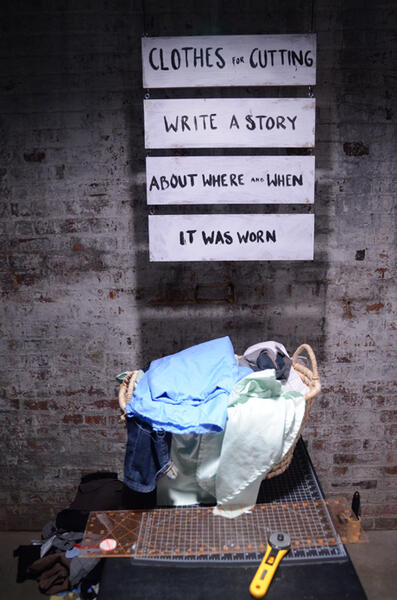 Cut Pieces - story viewAfter donation clothes, visiting could write a story about the piece, to be included in the quilt. For the exhibition Down Through the Needle's Eye, Hannah Brancato and Charlotte Keniston created a space for a clothing swap, fostering interaction and a consciousness about consumption. Stained or otherwise un-wearable garments were cut up and stitched together by the artists to create quilts in the gallery during workshop days throughout the exhibition. When people submitted garments for the quilt they wrote a few sentences about the garment's history- where did it come from? When did you wear it? How long did you have it? Pockets throughout the quilts hold transcriptions of these stories.
Cut Pieces - story viewAfter donation clothes, visiting could write a story about the piece, to be included in the quilt. For the exhibition Down Through the Needle's Eye, Hannah Brancato and Charlotte Keniston created a space for a clothing swap, fostering interaction and a consciousness about consumption. Stained or otherwise un-wearable garments were cut up and stitched together by the artists to create quilts in the gallery during workshop days throughout the exhibition. When people submitted garments for the quilt they wrote a few sentences about the garment's history- where did it come from? When did you wear it? How long did you have it? Pockets throughout the quilts hold transcriptions of these stories. -
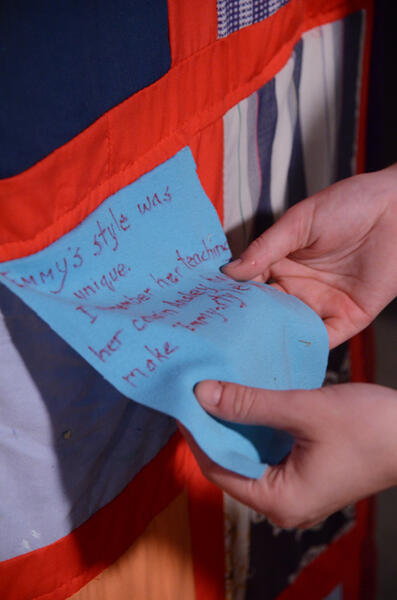 Cut Pieces - detail viewThis detail shows one story added to the quilts. For the exhibition Down Through the Needle's Eye, Hannah Brancato and Charlotte Keniston created a space for a clothing swap, fostering interaction and a consciousness about consumption. Stained or otherwise un-wearable garments were cut up and stitched together by the artists to create quilts in the gallery during workshop days throughout the exhibition. When people submitted garments for the quilt they wrote a few sentences about the garment's history- where did it come from? When did you wear it? How long did you have it? Pockets throughout the quilts hold transcriptions of these stories.
Cut Pieces - detail viewThis detail shows one story added to the quilts. For the exhibition Down Through the Needle's Eye, Hannah Brancato and Charlotte Keniston created a space for a clothing swap, fostering interaction and a consciousness about consumption. Stained or otherwise un-wearable garments were cut up and stitched together by the artists to create quilts in the gallery during workshop days throughout the exhibition. When people submitted garments for the quilt they wrote a few sentences about the garment's history- where did it come from? When did you wear it? How long did you have it? Pockets throughout the quilts hold transcriptions of these stories.
What Gives People Power
In this installation of the audio interviews, I created a listening booth encrusted with stereotypes about what gives people power. When visitors stepped inside the booth, they listened to honest and real reflections of that same subject.
This project is a collaboration between Sharlene McNeil and Hannah Brancato, with contributions from Naomi M., Lakiesha F., and Anita R
Hear the interviews: https://whatgivespeoplepower.wordpress.com/house-of-ruth-interviews-2009-2010/
-
What Gives People Power - Listening Booth8' x 3' x 3' Toy guns, plastic diamonds, paper money, feathers, fake flowers, yarn, books, remote controls, fake hair, mirrors, electrical cords, oral histories, media recorder. Listening booth for interviews about power and control from the House Of Ruth Maryland. Visitors were invited to leave audio and written responses inside the booth. http://www.whatgivespeoplepower.wordpress.com
-
 What Gives People Power - ResponsesSome of the responses left inside the booth when it was exhibited at MICA and the Enoch Pratt Central Library. “What Gives People Power” is an oral history project focused on people defining power and control, based on their personal experience. Through interviews with domestic violence survivors and perpetrators, as well as staff and volunteers from the House Of Ruth Maryland, the project documents connections between perceptions of power and the cycle of violence. The resulting stories give voice to the stigmatized issue of domestic violence, while bringing to light the diverse ways and means that people empower themselves. In this installation of the audio interviews, I created a listening booth encrusted with stereotypes about what gives people power. When visitors stepped inside the booth, they listened to honest and real reflections of that same subject. This project is a collaboration between Sharlene McNeil and Hannah Brancato, with contributions from Naomi M., Lakiesha F., and Anita R Hear the interviews: https://whatgivespeoplepower.wordpress.com/house-of-ruth-interviews-2009-2010/
What Gives People Power - ResponsesSome of the responses left inside the booth when it was exhibited at MICA and the Enoch Pratt Central Library. “What Gives People Power” is an oral history project focused on people defining power and control, based on their personal experience. Through interviews with domestic violence survivors and perpetrators, as well as staff and volunteers from the House Of Ruth Maryland, the project documents connections between perceptions of power and the cycle of violence. The resulting stories give voice to the stigmatized issue of domestic violence, while bringing to light the diverse ways and means that people empower themselves. In this installation of the audio interviews, I created a listening booth encrusted with stereotypes about what gives people power. When visitors stepped inside the booth, they listened to honest and real reflections of that same subject. This project is a collaboration between Sharlene McNeil and Hannah Brancato, with contributions from Naomi M., Lakiesha F., and Anita R Hear the interviews: https://whatgivespeoplepower.wordpress.com/house-of-ruth-interviews-2009-2010/ -
 What Gives People Power - booth detail“What Gives People Power” is an oral history project focused on people defining power and control, based on their personal experience. Through interviews with domestic violence survivors and perpetrators, as well as staff and volunteers from the House Of Ruth Maryland, the project documents connections between perceptions of power and the cycle of violence. The resulting stories give voice to the stigmatized issue of domestic violence, while bringing to light the diverse ways and means that people empower themselves. In this installation of the audio interviews, I created a listening booth encrusted with stereotypes about what gives people power. When visitors stepped inside the booth, they listened to honest and real reflections of that same subject. This project is a collaboration between Sharlene McNeil and Hannah Brancato, with contributions from Naomi M., Lakiesha F., and Anita R Hear the interviews: https://whatgivespeoplepower.wordpress.com/house-of-ruth-interviews-2009-2010/
What Gives People Power - booth detail“What Gives People Power” is an oral history project focused on people defining power and control, based on their personal experience. Through interviews with domestic violence survivors and perpetrators, as well as staff and volunteers from the House Of Ruth Maryland, the project documents connections between perceptions of power and the cycle of violence. The resulting stories give voice to the stigmatized issue of domestic violence, while bringing to light the diverse ways and means that people empower themselves. In this installation of the audio interviews, I created a listening booth encrusted with stereotypes about what gives people power. When visitors stepped inside the booth, they listened to honest and real reflections of that same subject. This project is a collaboration between Sharlene McNeil and Hannah Brancato, with contributions from Naomi M., Lakiesha F., and Anita R Hear the interviews: https://whatgivespeoplepower.wordpress.com/house-of-ruth-interviews-2009-2010/
Move Slowly
Move Slowly is an interview series and visual art project featuring conversations between creative activists working to end sexual violence, about the toll activism can take on our bodies, relationships, hearts and minds, and how to create visionary and supportive communities of care. Each interview will be paired with a portrait of the interviewee, based on their words and cyanotype prints of their hair (forthcoming). Through public art and collective storytelling, I am seeking to share and find insights about the relationship between movement building and self-preservation.
For each activist interview, I created a portrait of the activist featuring prints of their hair and a quote from our conversation.
-
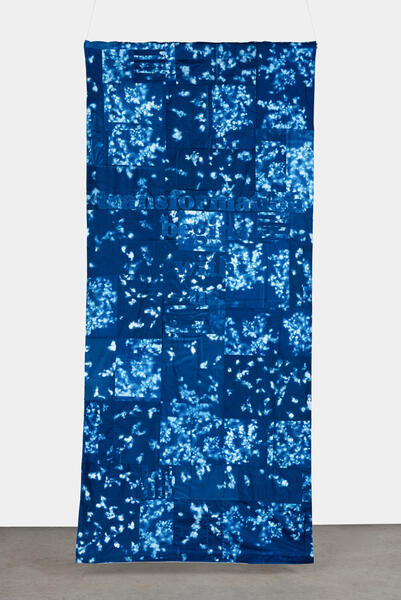 Move Slowly Portrait - Alexis Flanagan
Move Slowly Portrait - Alexis FlanaganThis portrait of Alexis Flanagan says, "we can tell new stories." Her full interview is available here.
-
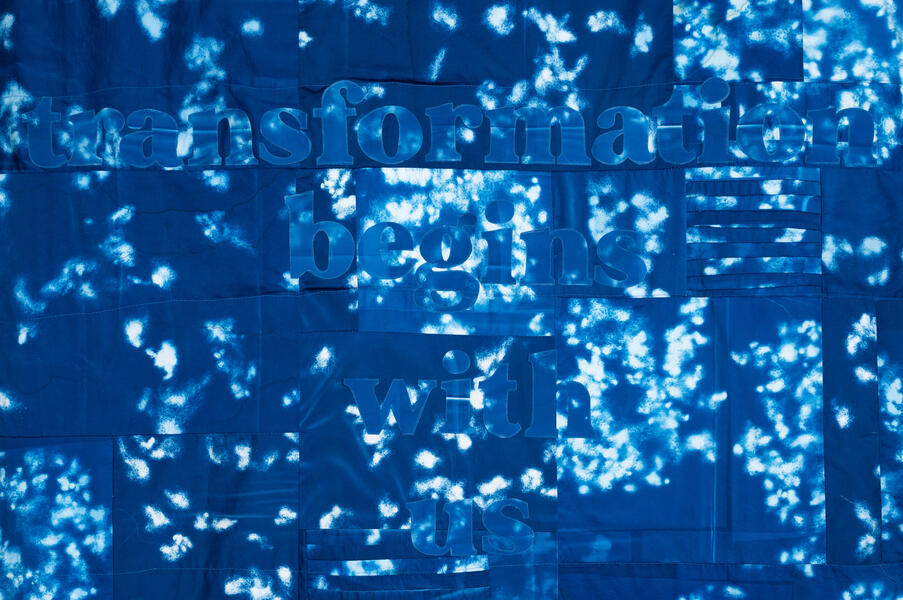 Detail View - Transformation Begins with Us
Detail View - Transformation Begins with Us -
Audio Sample - Alexis Flanagan Interview
This 3 minute sample of Alexis Flanagan's interview features her reflections about dreaming for the future. Each full conversation was one hour and was edited into a podcast style version that can be heard on Soundcloud.
-
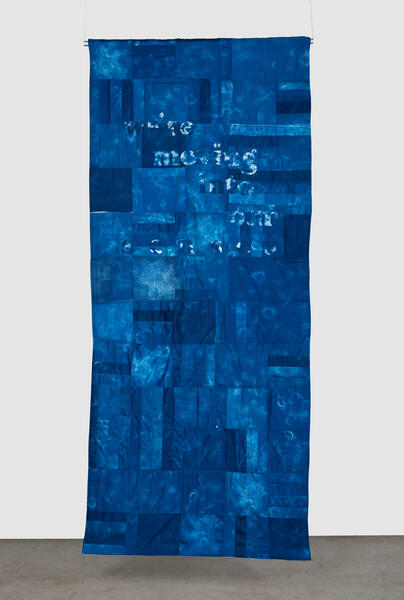 Move Slowly - Jadelynn St Drew
Move Slowly - Jadelynn St DrewThis portrait of Jadelynn St Dre features the words, "Transformation Begins With Us." Jadelynn's full interview can be heard here.
-
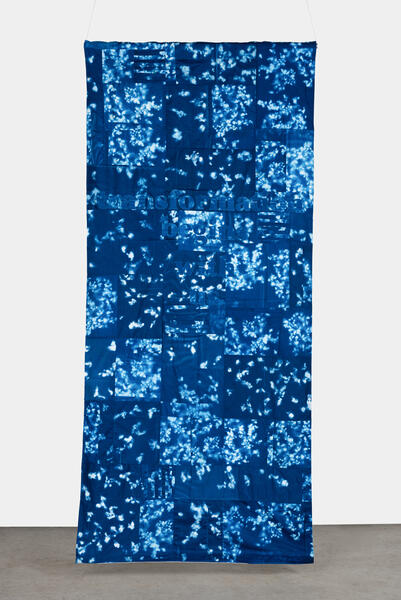 Move Slowly Portrait - Nuala Cabral
Move Slowly Portrait - Nuala CabralMove Slowly portrait of Nuala Cabral, featuring the words "Find Community."






